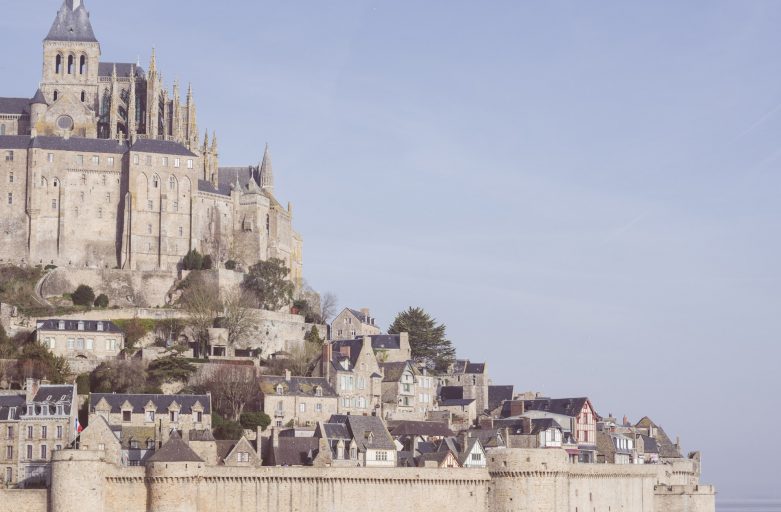Built in 1986 in honor of the Coptic saint Samaan al Kharaz (Simon the Tanner), one thousand years after his miracle and his death, the monastery contains seven churches and chapels hidden in a series of natural caves in the Muqattam hills. Saint Samaan Monastery is a new monastery, but nevertheless a beautiful place in a unique location with many stories and legends connected to it. Perched atop of the Muqattam hills it overlooks the garbage collectors’ community, the Zabaleen, in Manshiet Nasser.
Driving up the narrow steep village streets, passing piles of plastics, metal and food waste on each side of the alleys and people sorting them out, seemed like a ride through hell which finally ended at the gate of the monastery at an unexpected, stunning vast open space. Spectacular colored carvings engraved in stone all over the mountains depict scenes of the bible.
The discovery of an engraved figure of the Virgin Mary holding the baby Jesus – now up on the ceiling to the right side of the alter actually led to the construction of the main church named after the Virgin Mary and St Simon . The semi-circular auditorium descending into the mountain is awesome and offers seating for 20000 people.
Miracles are still happening. By pure coincidence another amazing cave inside the Monastery compound was discovered during construction works. The church was named after St. Bola, who lived in caves in complete solitude for 70 years. This same church witnessed another wonder, when in January 1992 a fire caused by an electric spark, damaged the entire interior, but left the pictures and the altar unharmed.
In 1979 a cave, which is now the St. Mark’s Church and St. Simon Hall, was discovered and in many years of arduous work freed from tons of rocks reaching a height of 17 meters. The upper St Simon’s Hall can accommodate up to 2000 people. Here, too, the walls are decorated with many wonderful pictures of the bible engraved in stone.
Saint Simon’s Monastery incorporates an educational center, a kindergarden, a school for the deaf and dumb, literacy and vocational courses and many activities for the zabbalin community.
The Legend:
The miracle of Muqattam fits well with the spirit of tolerance during the Fatimid times under its ruler Muizz el Din in the 10 th century. Caliph Muizz, a philosopher himself encouraged intellectual open discourse among Muslim, Christian and Jewish religious leaders. During one of these debates he asked patriarch Ephraim, if it were true what is written in the bible that if a man had faith he could move mountains. Muizz gave him four choices: to fulfill the commandment, to abandon his faith and espouse Islam, to emigrate or to be smitten by the sword.
Faced with such a difficult choice, the patriarch met with monks and clergy men inside the Hanging Church in prayers and fasting.
The fasting continued for three days. In the evening of the third day the exhausted patriarch fell asleep and in a dream the Virgin Mary told him that he would find a one-eyed man in the street. Done as told, before dawn Ephraim went out into the streets and indeed met Samaan carrying a goat-skin filled with water slung over his shoulder. Samaan humbly told him about his pious life, serving the elderly and sick and those who were not able to carry water, then started his work in the tannery. In the evening he drew water for the poor, before he turned to prayer.
Samaan learned about the partiarch’s vision and told him not to fear but to lead a procession of clerics and monks carrying crosses, candles and the gospels up the mountain. The group was split into two facing each other in prayer on the opposite sides of the mountain. Samaan himself would mingle with the people, but asked to remain unrecognized. Before the multitude of people and in presence of the Caliph, the patriarch drew the sign of the cross and suddenly a powerful earthquake rocked the city. The Muqattam hills rose up, so that the sun could be seen shining beneath and then reverted to its place. The Caliph acknowledged the faith and promised the patriarch the grant to build a church to Saint Mecarius. When Ephraim looked around searching for the saint, Samaan was nowhere to be seen.
In rememberance of the miracle the church has added the three days of fasting to the 40 days Christmas fast, making it a total of forty-three days, lasting from November 25 to January 6. Coptic Orthodox Christmas is hold on January 7th.
Another miracle is needed. Like Samaan was serving the poor and the ailing, the garbage collectors’ community needs your support. Even if described in detail, the Zabbalin village is a place hard to describe and far beyond imagination; it can only be grasped on site. If you are interested we invite you to continue to read about the Zabbalin. If you would like to contribute to one of the NGOs who are active in the area fighting diseases, illiteracy and for a better life, please contact us: excel@exceltrvl.net.

